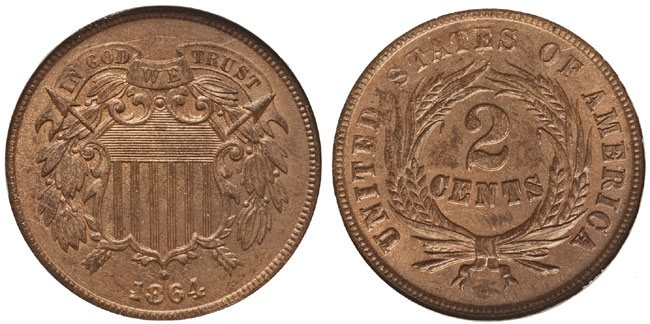Guide to U.S. Two Cent Pieces
The Two Cent Piece is one of the short-lived, odd denominations of the United States monetary system. Struck from 1864 to 1873, these coins never seemed to fit anywhere and experienced declining annual mintages until the series was discontinued. The Two Cent Piece does hold an important place in history as the first coin struck for circulation that carried the motto “In God We Trust.” This motto was later added to other denominations and remains in use on all circulating United States coins of the modern era.

The Two Cent Piece was not included in the original Coinage Act of 1792, but proposals for such a denomination would occur throughout the 19th century. The earliest proposal came in 1806 when a bill was introduced in Congress by Senator Uriah Tracy calling for the coinage of two cent pieces as well as twenty cent pieces. At the time it was believed that the value of the metal content of coinage should reflect its face value. This led to the consideration of using billon, an alloy of a precious metal mixed with a base metal. The proposed alloy would consist of 6.4 grains of silver and 24.3 grains of copper. The bill passed the Senate in early 1807 but eventually died in the House. The concept was deemed too expensive to produce and unlikely to be accepted by the general public.
The concept of the Two Cent Piece was considered for a second time in 1836 when the Mint experimented with the format and proposals were drafted. Billon was explored once again, although this time consisting of 10% silver and 90% copper. Patterns were created by Christian Gobrecht, but the concept was abandoned when Melter and Refiner Franklin Peale showed that the alloy could be easily counterfeited. Counterfeiting was a significant concern in the 19th century, and a coin capable of being counterfeited with cheap materials was immediately considered unfit for coinage.
The third attempt to introduce the denomination would come during the American Civil War amidst a national coin shortage. By this time, the large cent had been replaced by the small cent, and most people did not expect full metal value to be present in the lower denominations. The Coinage Act of 1864 was passed to authorize a change in composition for the small cent from copper-nickel to bronze, as well as establish the two cent denomination struck in bronze. Patterns were produced in 1863 and 1864 featuring various designs, although a design with a shield motif by James Barton Longacre would eventually be selected for the new denomination.
The obverse of the Two Cent Piece features a heraldic shield containing thirteen vertical stripes bound by horizontal lines above. The shield is bordered by laurel branches and a pair of crossed arrows are placed behind. The date appears slightly curved below. A scroll is placed above the shield displaying the motto IN GOD WE TRUST for the first time on circulating coinage. The motto had been devised by Treasury Secretary Salmon Chase and Mint Director James Pollock in response to a request from Reverend Mark R. Watkinson to add a reference to God on national coinage during the time of war. In the following year, Congress would pass legislation requiring “In God We Trust” to be placed on all circulating coinage large enough to accommodate the motto.
The reverse design of the Two Cent Piece contains an open wreath of wheat bound at the base. The inscription UNITED STATES OF AMERICA appears surrounding the wreath, with the denomination 2 CENTS placed within.
Production of the Two Cent Piece commenced at the Philadelphia Mint in 1864, with a total output of almost 20 million coins. These entered circulation and were somewhat accepted by the general public, although they would never become widely popular. Production numbers dropped sharply over the next few years. By the final year circulation production in 1872, only 65,000 pieces were struck, followed by a final proof-only issue in 1873. Under the Mint Act of 1873, a number of denominations were discontinued, including the Two Cent Piece. The coins would slowly disappear from circulation over the next few years and were soon mostly forgotten by the public.

